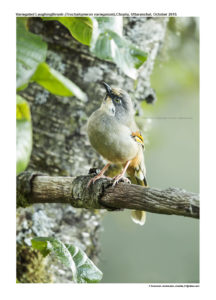Variegated Laughingthrush

Variegated Laughingthrush Garrulax variegatus
Habitat:
- Garrulax : Latin word garrulous –babbling, chattering; ax – inclining towards
- Variegatus: Latin word for variegated derived from varius- diverse
Vernacular Names: Nepal: Ganza
Distribution in India: Resident in Western and Central Himalayas in India.
Description: Size of 23-24 cm.It is a medium-sized olive and buffy laughingthrush with whitish lower face, broad black mesial stripe and grey, black and white wings and tail. The nominate race has dull buff forehead, shading to vaguely streaked pale brownish-grey on crown; upperparts ochre-tinged greyish-olive, upperwing with strong cinnamon fringes of greater coverts, black primary coverts and markings on bases of secondaries, black tertials with whitish on outer webs, pale grey and pale ochrous-grey wing fringing; blackish tail with broad greyish subterminal band and white tip; lores, spot at base of lower mandible and area around eye blackish, shading greyer on ear-coverts; rest of submoustachial area is buff, shading backwards to whitish, with whitish-tipped blackish feathers on lower ear-coverts. The chin and central throat are blackish; breast and belly are ochrous grey-brown or buffish-grey, shading to ochrous-rufous on lower belly, thighs and vent. The iris is pale yellow or pale yellow-green to pale yellowish-brown or brown; bill blackish to dark brown, yellow base of lower mandible; legs are pale reddish orange-brown or pale brown to flesh-coloured. Both the sexes are similar. The juvenile is slightly warmer and less distinctly patterned overall than adult. The races found in India are , Nominate race ( South Himachal Pradesh to Uttarakhand), race simile( North Himachal Pradesh) differs from nominate in having uniform silvery-grey fringing on outer tail, primaries and secondaries, paler and duller forehead, greyer upperside, breast and flanks, and whiter throat side.
Habitat: It is found in open forest of fir and birch or oak with dense rhododendron and bamboo growth and bushes; dwarf rhododendron at or above tree-line at forest edge, various types of dense jungle and undergrowth, particularly in winter, open willow groves; occasionally enters gardens. Found at 1800–4200 m in summer; some descend locally as low as 1000 m during extreme winter weather.
Food habits : It eats insects, fruit and berries. It is found in pairs during breeding season; otherwise in parties of up to 20 or more birds. It forages among bushes and on ground, but often ascends trees.
Breeding habits: They breed in Apr–Aug. The nest is compact, sometimes untidy, but usually rather shallow cup, made of coarse grasses, dead leaves, strips of birch bark, roots, twigs, moss, finer and softer grasses and fir needles, lined with rootlets, fine grasses and pine needles, placed above ground in bush, small tree or lower branch of larger tree, sometimes in thick grass tuft. They lay a clutch of 2–5 eggs. The incubation is done by both sexes. Brood parasitism is done by Indian Cuckoo.